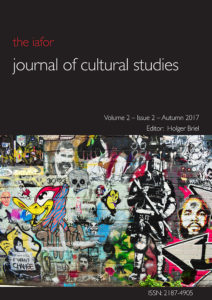IAFOR Journal of Cultural Studies: Volume 2 – Issue 2
Editor: Professor Holger Briel, Xi’an Jiaotong-Liverpool University, China
Published: October 16, 2017
ISSN: 2187-4905
https://doi.org/10.22492/ijcs.2.2
Introduction to the Issue

As the journal enters its third year of existence, it might be a good idea to stop for a moment and reflect upon the distance the journal has already covered in its short time of existence. It was and continues to be the aim of the journal to inform about and engage with the latest developments in cultural studies globally. With the first four issues published, it can be said that it has certainly fulfilled this aim. Insightful and engaged articles charted and continue to chart the waters of cultural studies globally, spanning discussions of spirituality, ethnic rituals, linguistic interventions, media futures and much more. There is a wide breath of topics in evidence and the quality of contributions is at times humbling.
So it is time to thank all the individuals and institutions involved in making this journal a big success. First and foremost, thanks go to all the authors who have worked hard on their cutting-edge research in order to present it here to a global audience. I would also like to thank IAFOR and its editorial staff for making this publication possible in the first place. Thanks also go to the multitude of reviewers who have given us their time and expertise in order to analyse possible contributions, make valuable suggestions and engage with topics in a professional, supportive manner. Last but not least, a thank you to the changing local editorial staff who have enriched the contributions with their insightful and expert knowledge. The journal will strive to continue along this successful trajectory made possible by all the aforementioned in the future and thus give back to the worldwide community of cultural studies researchers and practitioners.
For issue 2.2, I would like to welcome a new addition to the staff. Joshua Synenko will take over as the Journal's Book Review Editor. Book reviews will feature prominently in the following issues and will present a valuable overview of new publications in the burgeoning field of cultural studies.
The issue at hand opens with Pawel Zygadlo's “Patriotic Rhetoric in Chinese Public Spaces”. In his text, Zygadlo examines public spaces in China. After giving a history of such spaces in China, he analyses government messages publicised and communicated in such spaces in a variety of manners. His research culminates in the conclusion that these messages have shifted comprehensibly over the last decades in style and content and the discussion of why this is the case.
The next article also remains in China. Jing Yang's “American Cinematic Discourses of Women’s Oppression in Old China: From The Good Earth to Pavilion of Women” compares and contrasts the two films from her title and analyses how Western mediated images of China have changed in the time period between the making of these two films. Interestingly enough, she comes to the conclusion that many of the stereotypes of orientalism have not changed all that much over the decades and takes the film industry to task to portrait a more up-to-date and realistic image of China in its products.
“Immigration, Identity and Mobility in Europe: Inclusive Cultural Policies and Exclusion Effects” by Maxime Jaffré, Emmanuel Pedler and Elena Raevskikh analyses EU cultural interventions in Marseilles by researching the publics' reaction two theatres in this city. They come to the conclusion that while the EU's funding policies are indeed well-intentioned, much of this funding is doing little to change cultural power distribution in urban areas, which ought to have been addressed in the first place.
Jamal Shah and Bican Şahin’s “A Liberal Assessment of Intercultural Relations in Khyber Pakhtunkhwa, Pakistan” investigates intercultural relations in a particular remote area in Pakistan. He draws a dire image of present intercultural relations there and advises a strong change in policies.
In “Me, My Selfie, and I: Personal Photo-Sharing as a Form of Self-disclosure on Social Media”, Patricia Williamson, Trey Stohlman and Heather Polinsky write about the most popular image making media practice today, the selfie. Their assessment of the phenomenon makes it clear that selfie taking is much more than just a passing fad; rather, it has strong repercussions for social communicative practices, one's self-image and the way we perceive the world in general.
“The Analysis of Personal Supernaturalism Using World View Theory” by Shelley Ashdown uses World View Theory in order to compare reactions to supernaturalism in a number of communities. Her research testifies to the fact that supernaturalism is not an isolated, but rather a shared trait across cultures, with a surprising number of similar practices existing across communities.
Finally, Bill Phillips' “Crime Fiction and the City” gives a fascinating account of traditional crime fiction and its relationship to the city. He demonstrates that it is actually not only the individual city which gives crime fiction its distinct character, but, on a grander scale, the development of urban sceneries as backdrop to the stories in general which make this genre so popular.
Holger Briel
Editor

